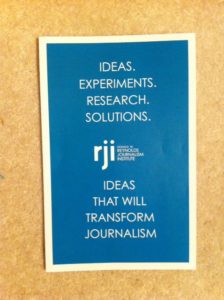See also: A short history of the origins and purposes of ITEGA (link)
ITEGA was incubated starting in 2008 by the Donald W. Reynolds Journalism Institute at the University of Missouri. It began as a research program for a one-year fellowship by Bill Densmore. (READ THE ORIGINAL PROPOSAL) It was informed by a 2007 meeting at MIT as well as thinking dating back to 1994. (See: The “four-party model”).
 Founding meeting at Pocantico
Founding meeting at Pocantico
ITEGA’s founding meeting took place at the Pocantico Center of the Rockefeller Brothers Fund in Tarrytown, N.Y., in April, 2018 and involved some 30 participants. (Read the outcomes report from Pocantico.) But it was preceeded by years of research, convenings and study.
Highlights:
During 2015, pursuant to its “call to action”, the Donald W. Reynolds Journalism Institute convened five task-group meetings in five U.S. locations involving more than 40 U.S. news industry participants, researchers, experts and observers to consider a call to action drawn from the research report “From Persona to Payment.”
The task groups addressed four aspects of member/partner development, authentication and identity management, content description-tagging-sharing and selling; and user data and exchange.
“FROM PERSONA TO PAYMENT” — A 2015 white paper
A 2015 report and white paper updated research in 2010-2011 by RJI fellow Bill Densmore. Densmore was asked then to write a “white paper” assessing the journalism landscape in light of two years of research by the Information Valet Project. The report executive summary and findings made a key recommendation about how to sustain the values, principles and purposes of journalism.
Accompanying the 2015 report were a series of supplemental stories including:
- Privacy: The evolving meaning of a single word for our networked news and information economy / Also: 2009 RJI privacy survey
- The opportunity for networks: Trust, antitrust and sharing users
The 2015 report did not detail consumer services or plead for a particular industry’s survival. Rather, it argued for infrastructure collaboration around new services that can sustain the values, principles and purposes of journalism for a participatory democracy. Unless journalism publishers respond, bundlers, aggregators and platform owners would become the dominant providers – and financial beneficiaries — of providing information to citizens, it concluded.
“FROM PAPER TO PERSONA” — The 2011 white paper
An earlier 54-page paper, From Paper to Persona: Managing Privacy and Information Overload; Sustaining Journalism in the Attention Age, was published Aug. 4, 2011. (SUMMARY) Key points asserted in the paper and an accompaning public announcement:
“A non-profit collaboration to share technology, users and content could help news organizations find new revenues and become better at serving the public, according to a report from the Donald W. Reynolds Journalism Institute at the University of Missouri.”
It found:
- Mass-market advertising won’t sustain traditional journalism
- New revenue streams are needed
- A promising opportunity is for news organizations to become stewards and curators of individual user’s ‘persona’ and information needs; earning subscription and transaction fees by doing so.
- A network is needed to maximize the value to consumers and revenue to the news industry. The network needs to be trusted by competitors.
- The best way to assure such a neutral network is for it to be created by a non-stock, public-benefit organization.
The report’s author called for the creation of a public-benefit entity (with a working title, “Information Trust Association”). It would help create and govern – but not own or operate – a shared-user network for trust, identity and information commerce layered atop and supporting the existing World Wide Web. (READ 2011 ANNOUNCEMENT)
The network, or exchange, would:
- Develop technical and information-service protocols and business rules
- Allow end users to own, protect — and optionally benefit by sharing — their demographic and usage data, with the help of their competitively chosen information broker or agent (“information valet”) – such as their local newspaper.
- Provide a platform for customizing and personalizing the end-user web experience – a “news social network.”
- Update the role, effectiveness of, and compensation for online advertising and marketing services beyond the mass market, while putting greater control of user privacy in the hands of users.
- Allow digital users to easily share, sell and buy content through multiple websites with one ID, password, account and bill.
 EARLIER — LAYING THE GROUNDWORK
EARLIER — LAYING THE GROUNDWORK
The Information Valet Project fellowship laid groundwork for the ITA concept through five events and ongoing conversations with dozens of thought leaders within the news and technology industries:
- “Blueprinting the InfoValet Economy,” Dec. 3-5, 2008, Columbia, Mo.
PROGRAM LINK / PARTICIPANT LINK / PHOTOS - “From Gatekeeper to InfoValet,” May 27, 2009, Washington, D.C.
PROGRAM LINK / PARTICIPANT LINK / HANDOUT / STORY - “From Blueprint to Building,” June 23-25, 2010, Columbia, Mo.
PROGRAM LINK / PARTICIPANT LINK - “Pivot Point,” June, 2012, Chicago
PROGRAM LINK / PARTICIPANT LINK / PRINCIPLES - “From Paper to Persona to Payment: Considering a New Ecosystem for News, Information and Privacy”, May 7, 2015, Chicago O’Hare Hilton
PROGRAM LINK / PARTICIPANT LINK / STORY / FOLLOWUP STORY / CASE STATEMENT / ACTION CALL
On May 5, 2009, Densmore summarized the Information Valet Project gatherings, research and findings in a 12-minute video presentation at RJI, accompanied by a slide deck about the RJI process..
In December, 2009, Densmore provided testimony about the ITA idea at a Federal Trade Commission public symposium. The testimony posted on the IVP wiki pages with accompanying slides, has been accessed more than 33,000 times since it was posted: http://www.newshare.com/wiki/index.php/Jta
RELATED HISTORICAL LINKS:
- How it started: The Information Valet Project research proposal, 2008
- Article: The Attention Age and its opportunities for the newsmedia industry / Sept. 3, 2012
- AUDIO: Explaining the Information Trust Exchange idea (2010)
- ARGUMENT: What if Eisenhower had asked private industry to build interstate highways?


